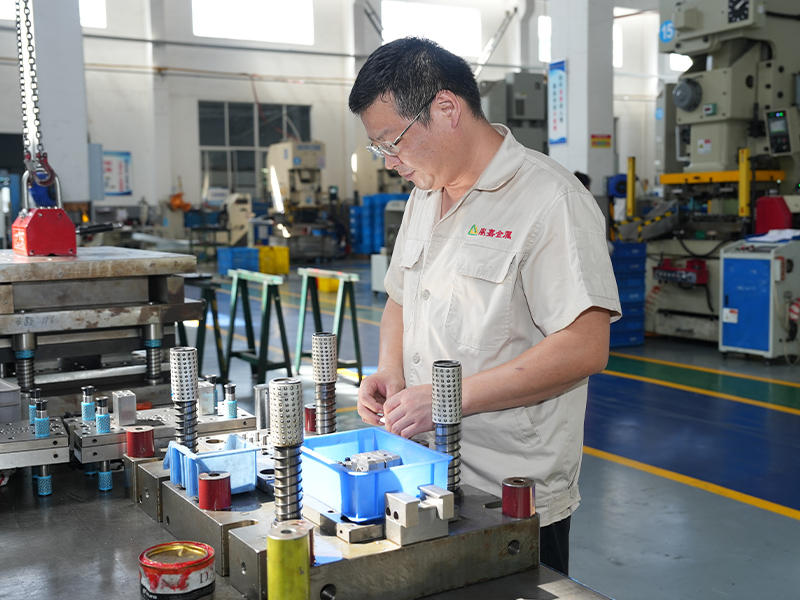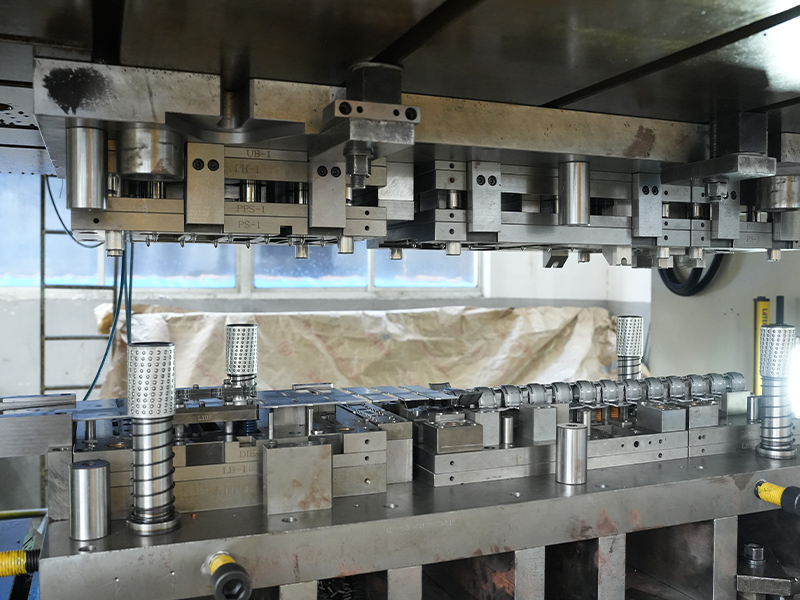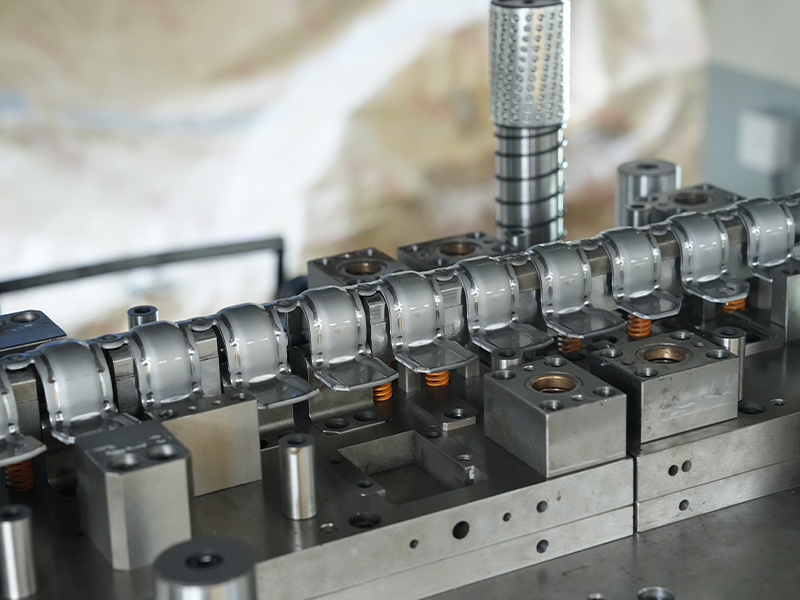Introduction to Aluminum Stamping Parts
Aluminum stamping parts are components crafted from aluminum through a stamping process. This manufacturing method involves applying force to aluminum sheets or blanks using dies and presses to shape them into desired forms. Aluminum, with its unique properties, has become a favored material for stamping, leading to the production of parts with distinct characteristics.
What is Aluminum Stamping?
Aluminum stamping is a sheet - metal forming process. A flat piece of aluminum, typically in the form of a coil or sheet, is fed into a press. The press, equipped with a die set (a male and a female die), exerts pressure on the aluminum. As the press closes, the aluminum is forced to conform to the shape of the die cavities. This process can create a wide range of shapes, from simple flat - cut pieces to complex three - dimensional components.
Why Choose Aluminum for Stamping?
Lightweight yet Strong: Aluminum has a significantly lower density compared to many other metals, such as steel. Its density is approximately one - third that of steel. Despite its low weight, aluminum can be alloyed to achieve high strength - to - weight ratios. For example, alloys like 6061 - T6 offer excellent strength, making them suitable for applications where weight reduction is crucial without sacrificing structural integrity, such as in the aerospace and automotive industries.
Corrosion Resistance: Aluminum naturally forms a thin, protective oxide layer on its surface when exposed to air. This oxide layer is highly resistant to corrosion, protecting the underlying metal from further degradation. In contrast to steel, which rusts when exposed to moisture and oxygen, aluminum stamping parts can maintain their integrity in various environments, including humid and corrosive ones. This property makes them ideal for outdoor applications, marine equipment, and food and beverage packaging.
Good Ductility and Malleability: Aluminum is highly ductile and malleable, which means it can be easily deformed without cracking during the stamping process. This property allows for the creation of complex shapes with tight tolerances. Whether it's a deep - drawn part or a component with intricate details, aluminum can be shaped to meet the most demanding design requirements.
Thermal and Electrical Conductivity: Aluminum exhibits high thermal and electrical conductivity. It has about 60% of the electrical conductivity of copper on a weight - for - weight basis. This property makes aluminum stamping parts suitable for applications in the electronics industry, such as heat sinks for electronic components to dissipate heat effectively and in electrical conductors where a combination of conductivity and lightweight is required.
Types of Aluminum Stamping Parts
Blanks
Blanks are the simplest form of aluminum stamping parts. They are flat, cut - out shapes from aluminum sheets. These shapes are often used as the starting point for further processing. For example, in the production of more complex stamped components, a blank might be cut to a specific size and shape, and then subjected to additional operations like bending, drawing, or embossing. Blanks can be used directly in some applications where a simple, flat - shaped aluminum piece is required, such as in certain types of packaging or as a base for attaching other components.
Drawings
Drawing is a process where a flat aluminum blank is transformed into a three - dimensional shape by stretching it over a die. Aluminum drawing parts are commonly found in industries where precision and complex shapes are needed. In the automotive industry, for instance, parts like automotive body panels, fuel tanks, and engine components are often produced through the drawing process. The ability of aluminum to be drawn into deep, complex shapes with consistent wall thicknesses makes it an ideal material for these applications.
Coinings
Coined aluminum parts are known for their high - precision and smooth, mirror - like finishes. The coining process involves applying high pressure to an aluminum blank between two dies with highly polished surfaces. This results in a part with sharp edges, fine details, and a very smooth surface. Coined aluminum parts are often used in the jewelry industry, where the aesthetic appeal is crucial. In the medical field, some surgical instruments and implants may also be coin - stamped to meet strict hygiene and precision requirements.
Embossings
Embossing creates raised or depressed patterns on the surface of an aluminum sheet. This can be for both decorative and functional purposes. In the packaging industry, embossed aluminum is used to add visual appeal to product packaging, such as on food cans or cosmetic containers. Functionally, embossed patterns can also improve grip, for example, on the surface of aluminum pedals in automotive or industrial equipment. The process can be used to create logos, text, or geometric patterns on the aluminum surface.
Extrusions (Related to Stamping in Some Contexts)
While extrusion is a different manufacturing process in itself, there are cases where extruded aluminum profiles are further processed using stamping techniques. Extruded aluminum parts are long, continuous shapes produced by forcing aluminum through a die. After extrusion, these profiles may be stamped to add features such as holes, notches, or bends. In the construction industry, window frames and door frames made from extruded aluminum may be stamped to fit together more precisely or to attach hardware.
Aluminum Stamping Part Specifications
Common Aluminum Alloys for Stamping
1100 Aluminum: This alloy is nearly pure aluminum (99% minimum aluminum content). It has high electrical conductivity, making it suitable for electrical applications such as busbars and electrical enclosures. It also offers good corrosion resistance and excellent workability, which makes it easy to stamp into various shapes. It is often used for spun parts, chemical equipment, and parts that will be anodized, as it anodizes well to provide an additional layer of protection and aesthetic finish.
2024 Aluminum: Known for its high strength - to - weight ratio and strong fatigue resistance, 2024 aluminum is widely used in the aerospace industry. Parts such as aircraft wings, fuselage components, and screw - machine components are often made from this alloy. During the stamping process, it can be formed into complex shapes while maintaining its structural integrity, even under high - stress conditions.
3003 Aluminum: A general - purpose alloy, 3003 aluminum is commonly used in sheet - metal applications. It has a good combination of strength, formability, and corrosion resistance. In the hardware industry, it is used for items like brackets and fasteners. It is also used in furniture manufacturing for components such as table legs and chair frames. In the kitchenware industry, it can be found in cooking utensils like pots and pans due to its heat - conductivity properties and ease of stamping into the desired shapes.
5052 Aluminum: Alloyed with chromium and magnesium, 5052 aluminum offers good corrosion resistance, especially in marine environments. It has excellent formability and is often used in sheet - metal ductwork in heating, ventilation, and air - conditioning (HVAC) systems. Its ability to be easily stamped into complex duct shapes, along with its resistance to corrosion from moisture in the air, makes it a preferred choice for this application.
6061 Aluminum: A precipitation - hardened alloy containing magnesium and silicon, 6061 aluminum has good weldability. It is used in a wide range of applications, including marine hardware, architectural structures, and aerospace components. In marine applications, it resists corrosion from saltwater. In architecture, it can be stamped into various shapes for use in building facades, handrails, and structural supports. In aerospace, it may be used for components that require a combination of strength, weldability, and the ability to be formed through stamping.
Stamping Thickness and Tolerances
The thickness of aluminum sheets used in stamping can vary widely depending on the application. Generally, stamping can be performed on aluminum sheets ranging from very thin foils (as thin as 0.006 inches) to relatively thick plates (up to about 0.250 inches or even thicker in some cases). Thinner sheets are often used for applications where weight reduction is critical and the part does not need to withstand high loads, such as in some electronics packaging. Thicker sheets are used for more robust applications, like structural components in automotive or industrial equipment.
Tolerances in aluminum stamping can be extremely tight, especially in high - precision applications. Modern stamping technology allows for tolerances as tight as ±0.001 inches in some cases. However, the achievable tolerance depends on several factors, including the complexity of the part, the type of stamping equipment used, and the aluminum alloy. For example, parts with simple geometries and using more malleable alloys may be stamped with tighter tolerances compared to complex - shaped parts or alloys that are more difficult to work with.

Applications of Aluminum Stamping Parts
Aerospace Industry
In the aerospace sector, weight reduction is of utmost importance to improve fuel efficiency and increase payload capacity. Aluminum stamping parts are extensively used in aircraft construction. Components such as aircraft fuselages, wings, and engine parts are often made from aluminum alloys. For example, the 2024 and 6061 aluminum alloys, with their high strength - to - weight ratios, are used to stamp parts that need to withstand the extreme forces experienced during flight. The ability to create complex shapes through stamping allows for the design and production of aerodynamically efficient components, contributing to better aircraft performance.
Automotive Industry
The automotive industry also benefits greatly from aluminum stamping parts. Aluminum is used to make various components, including car body panels, engine blocks, and suspension parts. Body panels made from aluminum are lighter than their steel counterparts, which helps to reduce the overall weight of the vehicle, leading to improved fuel economy and reduced emissions. Engine blocks made from aluminum alloys can dissipate heat more effectively, improving engine performance. Suspension parts made through stamping can be designed to be both lightweight and strong, enhancing the vehicle's handling and ride quality.
Electronics Industry
Aluminum stamping parts play a crucial role in the electronics industry. Heat sinks, which are essential for dissipating heat from electronic components such as computer processors and power amplifiers, are often made from aluminum. The high thermal conductivity of aluminum allows for efficient heat transfer, preventing overheating of sensitive electronic components. Additionally, aluminum enclosures for electronic devices are stamped to provide a lightweight, yet durable and protective housing. These enclosures can be stamped with features such as ventilation holes and mounting points, meeting the specific requirements of different electronic products.
Construction Industry
In construction, aluminum stamping parts are used in a variety of applications. Window and door frames made from stamped aluminum profiles offer a combination of strength, corrosion resistance, and aesthetic appeal. Aluminum roofing panels, which can be stamped into various shapes and patterns, are lightweight and durable, making them suitable for both residential and commercial buildings. In addition, structural components such as brackets and connectors may be made from stamped aluminum, providing reliable support while reducing the overall weight of the building structure.
Medical Industry
The medical industry requires high - precision and hygienic components. Aluminum stamping parts are used in the production of medical devices such as surgical instruments, implants, and diagnostic equipment. Coin - stamped aluminum parts, with their smooth surfaces and high precision, are ideal for surgical instruments that need to be easy to clean and free from any sharp edges or crevices where bacteria could accumulate. Implants made from biocompatible aluminum alloys, after being carefully stamped to the correct shape and size, can be used to replace or support damaged bones or tissues in the body.
Aluminum Stamping Processes
Forming
Forming is a fundamental process in aluminum stamping. It involves applying force to the aluminum alloy to modify its geometry. This can include bending, rolling, or stretching the aluminum sheet. In bending, the aluminum is forced over a die to create a specific angle or curve. Rolling can be used to create cylindrical or curved shapes. Stretching is often used in the drawing process, where the aluminum blank is pulled over a die to form a three - dimensional shape. The forming process is carefully controlled to ensure that the aluminum does not crack or deform unevenly, especially when working with complex shapes.
Blanking
Blanking is a process where a punch and die are used to cut a specific shape (referred to as a blank) from an aluminum alloy sheet. The punch forces the aluminum through the die, separating the desired shape from the rest of the sheet. Blanking is typically the first step in creating many aluminum stamping parts. It produces minimal burrs, which is beneficial as it reduces the need for extensive finishing operations, thus saving time and cost. The accuracy of the blanking process is crucial as it determines the starting shape for subsequent operations.
Piercing
Piercing is similar to blanking, but instead of cutting out a complete shape, it is used to create holes, slots, or notches in the aluminum sheet metal. A punch and die are used, with the punch creating an opening in the sheet as it passes through the die. Piercing can form tight tolerances, resulting in clean - cut holes. Compared to drilling, piercing is often more productive, especially when creating multiple holes in a sheet. It can also produce a cleaner cut, which may be important for applications where the edges of the holes need to be smooth, such as in some electrical or mechanical components.
Drawing
As mentioned earlier, drawing is a process where tensile force is applied to stretch an aluminum alloy blank over a die until the desired thickness and shape are achieved. This is a precision - metal - stamping process used to create a wide range of products, from fluid - handling components like pipes and tanks to aircraft parts and electronic components. The drawing process requires careful control of factors such as the amount of force applied, the speed of the press, and the lubrication of the aluminum blank and die to ensure a successful outcome.
Stamping Equipment
Individual Stamping Machines: These come in various sizes and capacities. For example, a common range of individual punch machines may have specifications from 16 - 800 tons. Types include NC (Numerical Control) plane punches, which offer high precision and the ability to be programmed for complex punching patterns. Vertical four - post punches provide stability during the stamping process, making them suitable for heavy - duty applications. Precision punches are designed to achieve extremely tight tolerances, while high - speed punches are used for high - volume production, where speed is crucial to meet production demands.
Continuous Stamping Machines: Also known as progressive stamping machines, these are used for high - volume production of complex parts. They can have punch equipment ranging from 16 to 1000 tons. In a continuous stamping machine, the aluminum strip is fed through a series of dies in a single pass, with each die performing a different operation (such as blanking, piercing, and bending) in sequence. This allows for the efficient production of large quantities of parts with consistent quality.
Surface Finishes and Coatings for Aluminum Stamping Parts
Chem - Film
Chem - film, short for chemical film, is a thin, protective coating applied to aluminum surfaces. It is formed through a chemical reaction between the aluminum and a solution. Chem - film provides corrosion resistance and acts as a base for other coatings. It can improve the adhesion of paint or powder coatings, ensuring better durability of the overall finish. In addition, chem - film can enhance the electrical insulating properties of the aluminum, making it suitable for some electrical applications.
Paint
Painting aluminum stamping parts can serve both aesthetic and protective purposes. There are various types of paints available for aluminum, such as acrylic, epoxy, and polyurethane. Paint can be applied in different colors and finishes, from matte to glossy, to meet the design requirements of different products. The paint coating protects the aluminum from corrosion by acting as a barrier between the metal and the environment. In some applications, such as in automotive or consumer product exteriors, the paint also provides an attractive appearance.
Powder Coating
Powder coating is a popular finish for aluminum stamping parts. In this process, a dry powder (usually a mixture of resin and pigment) is electrostatically applied to the aluminum surface. The part is then heated, causing the powder to melt and flow, forming a smooth, durable coating. Powder coatings offer excellent corrosion resistance, hardness, and color retention. They are available in a wide range of colors and textures, making them suitable for both functional and decorative applications. Powder - coated aluminum parts are often used in outdoor furniture, architectural components, and industrial equipment due to their long - lasting finish.
Conclusion
Aluminum stamping parts have become an integral part of modern manufacturing across a wide range of industries. The unique properties of aluminum, such as its lightweight nature, high strength - to - weight ratio, corrosion resistance, and good formability, make it an ideal material for stamping. The variety of aluminum alloys available allows for customization to meet the specific requirements of different applications, from the high - strength needs of aerospace to the corrosion - resistant demands of the marine and construction industries.
The stamping processes, including forming, blanking, piercing, and drawing, enable the creation of parts with complex shapes and tight tolerances. Coupled with a range of surface finishes and coatings, aluminum stamping parts can be tailored to provide not only functional performance but also aesthetic appeal. As technology continues to advance, the aluminum stamping industry is likely to see further improvements in efficiency, precision, and the development of new alloys and processes, opening up even more possibilities for the use of aluminum stamping parts in the future.













